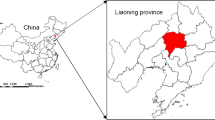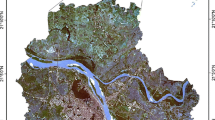Abstract
The construction of The Three Gorges Reservoir has changed land use structure and reconstituted landscape pattern as imparts significant influence upon the land use structure and ecological environment of Three Gorges Reservoir Regions. The ecological safety of reservoir area is extremely dependent on unique location and special geological conditions of Zhongxian County, the center of Three Gorges Reservoir Regions in Chongqing, and therefore, ecological environment of reservoir area will be changed with the transition of land use in Zhongxian County. Based on land use data in 2000, 2005, 2010, this paper chooses influencing factors from aspects of natural topographic and geomorphological conditions, accessibility to economic development and land use expansion, and then establishes Logistic-CA-Markov (Logistic-Cellular Automata-Markov) and WLC-CA-Markov (Weighted Linear Combination- Cellular Automata- Markov) models so as to simulate spatial pattern of land use of Zhongxian County. The results demonstrate that WLC-CA-Markov model established here has better controllability and higher simulation precision (the kappa coefficient is 0.9295). In the future development of Zhongxian County, the area of grassland and plow land will be reduced continuously, the area of construction land will be expanded obviously mostly because of the added area both near the water and in the north of Zhongxian county, the area of woodland will be increased to a little extent, the area of water area and unused land has gentle change. In the sustainable scenario, the area of grassland will be reduced slightly, the area of water area keeps steady, the area of plow land is reduced but higher than red line of plow land, the area of construction land is increased with significantly smaller increase amplitude than that in the natural development scenario, and the woodland is increased. This scenario coordinates ecological environment with economic development of regional society and turns out to be the best development scenario of land use.













Similar content being viewed by others
References
Aaviksoo K (1995) Simulating vegetation dynamics and land use in a mire landscape using a Markov model. Landsc Urban Plan 31(1–3):129–142
Aroengbinang BW, Kaswanto (2015) Driving force analysis of land use and cover changes in Cimandiri and Cibuni watersheds. Procedia Environ Sci 24:184–188
Bathrellos GD, Skilodimou HD, Kelepertsis A, Alexakis D, Chrisanthaki I, Archonti D (2008) Environmental research of groundwater in the urban and suburban areas of Attica region, Greece. Environ Geol 56(1):11–18
Chen Y, Li X, Liu X, Ai B (2014) Modeling urban land-use dynamics in a fast developing city using the modified logistic cellular automaton with a patch-based simulation strategy. Int J Geogr Inf Sci 28(2):234–255
Dang AN, Kawasaki A (2017) Integrating biophysical and socio-economic factors for land-use and land-cover change projection in agricultural economic regions. Ecol Model 344:29–37
Fu X, Wang X, Yang YJ (2017) Deriving suitability factors for CA-Markov land use simulation model based on local historical data. J Environ Manag 206:10–19
Guan DJ, Li HF, Inohae T, Su W, Nagaie T, Hokao K (2011) Modeling urban land use change by the integration of cellular automaton and Markov model. Ecol Model 222(20):3761–3772
Halmy MWA, Gessler PE, Hicke JA, Salem BB (2015) Land use/land cover change detection and prediction in the north-western coastal desert of Egypt using Markov-CA. Appl Geogr 63:101–112
Han Y, Jia H (2017) Simulating the spatial dynamics of urban growth with an integrated modeling approach: a case study of Foshan, China. Ecol Model 353:107–116
Hao HM, Ren ZY (2009) Land use/land cover change (LUCC) and eco-environment response to LUCC in farming-pastoral zone, China. Agric Sci China 8(1):91–97
He C, Okada N, Zhang Q, Shi P, Li J (2008) Modelling dynamic urban expansion processes incorporating a potential model with cellular automata. Landsc Urban Plan 86(1):79–91
He J, Huang J, Li C (2017) The evaluation for the impact of land use change on habitat quality: a joint contribution of cellular automata scenario simulation and habitat quality assessment model. Ecol Model 366:58–67
Kasetkasem T, Arora MK, Varshney PK (2005) Super-resolution land cover mapping using a Markov random field based approach. Remote Sens Environ 96(3):302–314
Kleemann J, Baysal G, Hnn B et al (2017) Assessing driving forces of land use and land cover change by a mixed-method approach in North-Eastern Ghana, West Africa. J Environ Manag 196:411–442
Kuang WH (2011) Simulating dynamic urban expansion at regional scale in Beijing-Tianjin-Tangshan metropolitan area. J Geogr Sci 21(2):317–330
Kundu S, Khare D, Mondal A (2017) Land use change impact on sub-watersheds prioritization by analytical hierarchy process (AHP). Ecol Inform 42:100–113
Li T, Li W (2015) Multiple land use change simulation with Monte Carlo approach and CA-ANN model, a case study in Shenzhen, China. Environ Syst Res 4(1):1
Li Z, Wu W, Liu X, Fath BD, Sun H, Liu X et al (2016) Land use/cover change and regional climate change in an arid grassland ecosystem of Inner Mongolia, China. Ecol Model 353:86–94
Li G, Zhang F, Jing Y, Liu Y, Sun G (2017) Response of evapotranspiration to changes in land use and land cover and climate in China during 2001-2013. Sci Total Environ 596-597:256–265
Liu XP, Liang X, Li X, Xu X, Ou J, Chen Y et al (2017) A future land use simulation model (FLUS) for simulating multiple land use scenarios by coupling human and natural effects. Landsc Urban Plan 168:94–116
Loehr D (2010) External costs as driving forces of land use changes. Sustainability 2(4):1035–1054
Long H, Qu Y (2018) Land use transitions and land management: a mutual feedback perspective. Land Use Policy 74:111–120
Luo G, Yin C, Chen X, Xu W, Lu L (2010) Combining system dynamic model and CLUE-S model to improve land use scenario analyses at regional scale: a case study of Sangong watershed in Xinjiang, China. Ecol Complex 7(2):0–207
Mondal MS, Sharma N, Garg PK, Kappas M (2016) Statistical independence test and validation of CA Markov land use land cover (LULC) prediction results. Egypt J Remote Sens Space Sci 19(2):259–272
Pang A, Li C, Wang X, Hu J (2010) Land use/cover change in response to driving forces of Zoige County, China. Procedia Environ Sci 2(6):1074–1082
Parsa VA, Salehi E (2016) Spatio-temporal analysis and simulation pattern of land use/cover changes, case study: Naghadeh, Iran. J Urban Manage 5(2):43–51
Peraltarivero C, Contrerasservín C, Galindomendoza MG, JeanFrançois Mas C, Algarasiller M (2014) Analysis of land use and land cover changes and evaluation of natural generation and potential restoration areas in the Mexican Huasteca region. Open J For 4(2):124–135
Pontius R, Schneider LC (2001) Land-cover change model validation by an ROC method for the Ipswich watershed, Massachusetts, USA. Agric Ecosyst Environ 85(1):239–248
Roodposhti MS, Aryal J, Bryan BA (2018) A novel algorithm for calculating transition potential in cellular automata models of land-use/cover change. Environ Model Softw. https://doi.org/10.1016/j.envsoft.2018.10.006
Samat N, Hasni R, Elhadary YAE (2011) Modelling land use changes at the Peri-urban areas using geographic information systems and cellular automata model. J Sustain Dev 4(6):72–84
Schirpke U, Leitinger G, Tappeiner U, Tasser E, Ecoinf J, Pattern L (2012) SPA-LUCC: developing land-use/cover scenarios in mountain landscapes. Ecol Inform 12(11):68–76
Shi RJ (2011) Ecological environment problems of the three gorges reservoir area and countermeasures. Procedia Environ Sci 10(1):1431–1434
Shu B, Zhang H, Li Y, Qu Y, Chen L (2014) Spatiotemporal variation analysis of driving forces of urban land spatial expansion using logistic regression: a case study of port towns in Taicang city, China. Habitat Int 43(4):181–190
Subedi P, Subedi K, Thapa B (2013) Application of a hybrid cellular automaton – Markov (CA-Markov) model in land-use change prediction: a case study of Saddle Creek Drainage Basin, Florida. Sci & Educ 1(6):126–132
Van AS, Verburg PH (2013) Land cover change or land-use intensification: simulating land system change with a global-scale land change model. Glob Chang Biol 19(12):3648
Wang H, Li X, Long H, Qiao Y, Li Y (2011) Development and application of a simulation model for changes in land-use patterns under drought scenarios. Comput Geosci 37(7):831–843
Wang SD, Wang XC, Zhang HB (2015) Simulation on optimized allocation of land resource based on DE-CA model. Ecol Model 314:135–144
Wang J, Lin Y, Glendinning A, Xu Y (2018a) Land-use changes and land policies evolution in china’s urbanization processes. Land Use Policy 75:375–387
Wang C, Wang Y, Wang R, Zheng P (2018b) Modeling and evaluating land-use/land-cover change for urban planning and sustainability: a case study of Dongying city, China. J Clean Prod 172:1529–1534
Xu QL, Yang K, Wang GL, Yang YL (2015) Agent-based modeling and simulations of land-use and land-cover change according to ant colony optimization: a case study of the Erhai Lake Basin, China. Nat Hazards 75(1):95–118
Xu X, Du Z, Zhang H (2016) Integrating the system dynamic and cellular automata models to predict land use and land cover change. Int J Appl Earth Obs Geoinf 52:568–579
Yang X, Zheng XQ, Lv LN (2012) A spatiotemporal model of land use change based on ant colony optimization, Markov chain and cellular automata. Ecol Model 233(2):11–19
Yang X, Zheng XQ, Chen R (2014) A land use change model: integrating landscape pattern indexes and Markov-CA. Ecol Model 283(7):1–7
Ying X, Zeng GM, Chen GQ, Tang L, Wang KL, Huang DY (2007) Combining AHP with GIS in synthetic evaluation of eco-environment quality—a case study of Hunan province, China. Ecol Model 209(2–4):97–109
Yu W, Zang S, Wu C, Liu W, Na X (2011) Analyzing and modeling land use land cover change (LUCC) in the Daqing city, China. Appl Geogr 31(2):600–608
Zhang L, Nan Z, Yu W, Zhao Y, Xu Y (2018) Comparison of baseline period choices for separating climate and land use/land cover change impacts on watershed hydrology using distributed hydrological models. Sci Total Environ 622-623:1016–1028
Zheng HW, Shen GQ, Wang H, Hong J (2015) Simulating land use change in urban renewal areas: a case study in Hong Kong. Habitat Int 46:23–34
Zhou QG, Lv ZQ, Ma Z, Zhang Y, Wang H (2011) Barrier belt division based on RS and GIS in the three gorges reservoir area ——a case of Wanzhou district. Procedia Environ Sci 10(Part B):1257–1263
Acknowledgements
This work is partially supported by the Science and Technology Research Program of Chongqing Municipal Education Commission (No. KJZD-K201800702), Basic Science and Advanced Technology Fund of Chongqing Scientific Council in China (No. cstc2017jcyjAX0210), Technology Innovation and Application Demonstration Fund of Chongqing Science and Technology Bureau in China (No. cstc2018jscx-mszdX0121), and Found of Graduate Student’s education innovation (No. 2018S0144).
Author information
Authors and Affiliations
Corresponding author
Additional information
Responsible editor: Marcus Schulz
Publisher’s note
Springer Nature remains neutral with regard to jurisdictional claims in published maps and institutional affiliations.
Rights and permissions
About this article
Cite this article
Guan, D., Zhao, Z. & Tan, J. Dynamic simulation of land use change based on logistic-CA-Markov and WLC-CA-Markov models: a case study in three gorges reservoir area of Chongqing, China. Environ Sci Pollut Res 26, 20669–20688 (2019). https://doi.org/10.1007/s11356-019-05127-9
Received:
Accepted:
Published:
Issue Date:
DOI: https://doi.org/10.1007/s11356-019-05127-9




